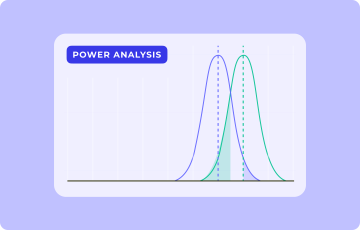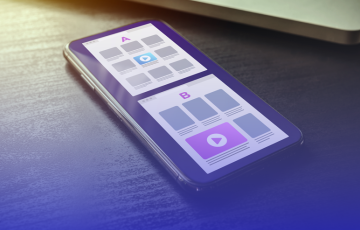
How do you measure the success of a personalization campaign?
According to our latest research, 75% of US consumers are looking for personalized online experiences.
Due to this an increasing number of brands are deploying online personalization strategies to meet visitors’ individual needs and thus boost conversion rates. Significant resources are being invested in areas such as choosing the right solution, creating a data-driven optimization culture in-house and training and sharing learning resources with digital marketing teams.
This why it’s crucial to be able to estimate the benefits associated with your personalization campaigns. How do you measure the success of your campaign? Which KPIs should you monitor? How do you calculate the return on investment?
1 Why launch a personalization campaign and the KPIs to monitor
Personalization improves the experience and journey of visitors to your website. Ultimately, the practice enables brands to benefit from greater engagement, higher conversion rates and increased cross-selling.
Before running a personalization campaign on your website, the first step is to set your goals. These enable you to measure its impact and allow you to adapt your strategy in real-time if necessary.
Conversion : A conversion is when a visitor targeted by your campaign performs the desired action (goal): add to cart, purchase confirmation or subscription to a newsletter for example.
Conversion rate (or transformation rate): the conversion rate indicates the number of visitors who have converted divided by the total number of visitors to your website.
Personalization can be used to accomplish multiple goals:
Boost revenue
Personalization enables you to create experiences adapted to each visitor and to deliver them at the right point in their digital journey.
From content to promotions, navigation, emails or even retargeting campaigns, you can optimize absolutely all your marketing actions by pushing them to the right people at the right time.
This enables you to optimize conversions for each customer journey and generate significant additional revenue compared to taking a generic, mass-marketing approach.
KPIs to monitor
- Increase in your overall conversion rates
- Reduction in cart abandonment
- Increase in average order value (AOV)
Increase visitor engagement
Personalization enables you to display targeted content (products, messages or offers) to individual visitors, showing them only the content and offers that are of most interest to them.
It’s vital to engage visitors if you are to encourage them to spend time on your website and move down the conversion funnel.
On media websites, which generate revenues through advertising, engagement is one of the main goals for a brand. On e-commerce websites, engagement is a vital first step towards conversion, then retention.
KPIs to monitor
- Increase in time spent on pages
- Increase in the number of pages viewed
- Increase in the number of accounts registered/members signed in
Reduce churn
The average conversion rate on a website is 2%, which means that the majority of your audience leaves your website without buying anything. That’s a churn rate of 98%! This is why it’s crucial to reduce the number of visitors passing through as much as possible.
Personalization enables you to identify the visitors who are about to leave your website without converting and to target them in real-time with a tailored experience.
For example, you can adapt their experience as they are leaving the website (through a pop-in), later on when they are browsing elsewhere (with personalized retargeting ads) or by email (via personalized reminders).
KPIs to monitor
- Reduce in bounce rates
- Reduce in cart abandonment rates
- Increase in conversions in particular visitor segments
Generate qualified leads
Generating qualified leads is a real challenge, especially in the banking or automotive sectors where the purchasing journeys are longer and often require a face-to-face meeting.
With personalization, you can optimize your lead-generation campaigns by targeting the most qualified visitors. Personalization will also help you send the right message to encourage them to provide their contact details, make an appointment or take an action that will engage them with your brand and move them down the funnel.
KPIs to monitor
- Increase appointment confirmations/quote requests
- Lower the cost of a lead
- Reduce the proportion of non-qualified leads
Guarantee an omnichannel experience
Delivering an omnichannel experience enables you to boost conversions and engagement as visitors get a quality experience, regardless of the device or channel they use to contact your brand.
Personalization enables you to optimize your omnichannel strategy by offering content that interests each visitor on all available channels. It’s crucial to match visitor data so that you can offer them a consistent experience and a high-quality purchasing journey across every channel and device.
You can also use your website as a bridge to your other channels (brick-and-mortar stores, telephone helpline, etc.) by identifying each visitor’s preferred channel and adapting the experience accordingly.
KPIs to monitor
- Increase in footfall and sales in your brick-and-mortar stores
- Increase in drive-to-store and BOPIS/click-and-collect numbers
- Increase in direct call-backs requests for advisers
Guarantee the ROI of promotional campaigns
For brands, running promotions can sometimes be synonymous with lower margins, as consumers that would have bought anyway take advantage of any discounts you offer.
By restricting your offers and promotions so that they are only targeted at the right visitors at the right time, you regain control over the ROI of your sales and marketing actions. Your costs are optimized and your marketing actions generate higher turnover as you don’t waste money offering promotions to those who already planned to buy from you.
KPIs to monitor
- Reduction in marketing campaign costs
- Increase in conversions
- Increase in additional turnover generated
Retain your customers
Because competition online is ever-increasing, it is essential to create long-lasting relationships with visitors so that they regularly come back to your website. To boost conversions and up-sell, brands must retain their visitors.
Personalization enables you to accurately meet visitor expectations rather than providing a less-engaging, generic experience. Over the long term, a well-orchestrated personalization strategy can make a difference and enable you to generate ongoing income streams.
KPIs to monitor
- Increase in the number of customers who regularly return to your website
- Increase in loyalty program sign-ups
- Increase in Customer Lifetime Value
2 A/B test your personalization campaigns
When running a personalization experiment, it’s vital to observe how your results evolve compared to a generic version. This is the only way to identify changes (positive or negative) in your business KPIs.
With A/B testing, you can run your personalized experiment in parallel with a generic experiment to measure the impact of the personalization.
Use A/B testing to measure the improvement of your KPIs
By testing your experiments, you can establish a rate of improvement in your main KPIs and measure the real impact of your experience.
Let’s look at an example: you target visitors interested in bikes, using a personalized promotional pop-in. Over a one-week period, you obtain 30 add-to-cart conversions through this experiment.
To measure the improvement in conversions compared to a non-personalized experience, you should ensure that a sample of relevant users aren’t exposed to the experience. This enables you to compare the performance of the personalization in real-time, essentially A/B testing your personalization campaigns.
You can then compare the number of conversions on the two versions of your page and identify the improvement obtained. For example, if you record 10 conversions on the non-personalized version and 30 on the personalized version, that means you have tripled your conversions through the personalization.
Use A/B testing to identify the risks linked to your experiment
Conversely, it’s also very useful to A/B test your personalizations to identify whether or not they had a negative impact on visitors’ purchasing journeys.
Indeed, an experiment that boosts the number of add-to-carts, for example, could simultaneously lead to a decrease in purchase confirmations - not a profitable move. So you need to keep an eye on these numbers if you want to be able to course-correct as quickly as possible.
Once you’ve measured the results of your personalization and proved it is successful you can use it on all of your targeted visitors to boost conversions across your wider audience.
3 Calculate the ROI of your personalization campaigns
To determine whether your personalization campaign is successful, you need to know how profitable it is. If the resources put in place to roll out the campaign exceed the gains obtained, then clearly the project is not profitable.
ROI (return on investment) is one of the most important indicators for measuring the success of your personalization campaigns. It enables you to identify the true impact of your actions on your bottom line and to therefore make strategic decisions.
To calculate the ROI of your marketing actions, the most commonly used formula is the following:

Actual gain vs potential gain
When you calculate the ROI of your personalization campaigns, you must also measure the experiment’s potential long-term impact.
Actual gain designates the income you generated over the duration of the experiment.
Potential gain designates the income you can generate by implementing your personalization long-term.
In other words, an experiment with very good results over a short time period can bring you great returns over the course of the year if it is definitively adopted and pushed out to all traffic (without a control sample).
4 Measure the additional benefits of personalization campaigns
A better relationship with visitors thanks to optimized UX
With personalization, the content presented on your website is relevant and visitors don’t have the feeling they’ve been bombarded with things they aren’t interested in. The quality of the experience and visitor satisfaction are therefore improved.
So, continuously running personalizations contributes to reinforcing your brand image and delivering an optimized omnichannel experience.
Better understand your audience
The benefits of personalization are not limited to your business KPIs. The practice enables you to get to know your website audience better and to thus improve your strategy over time.
The behavior of visitors on your website can change depending on the time period and their personal desires. It’s crucial to observe them and to adapt your strategy based on the insights gained. This is particularly true in the current environment, where consumer behavior is changing rapidly.
You can also identify the sources of the traffic that best converts on your website or the percentage of visitors who come back regularly, and use this to offer them experiences that better meet their expectations.
Save time and increase productivity
Personalization enables you to automate a certain number of tasks (targeting, personalization triggers) and to very quickly adapt the visitor experience.
The teams using Kameleoon say that the platform’s speed and flexibility enable them to be more responsive to visitor needs and to maintain control over the experience they provide.
Additionally, by using continuous optimization, teams can perform better and adopt the right habits in terms of data-driven experimentation.
If we go further, with AI-driven personalization the benefits are even greater, because algorithms are capable of automating time-consuming tasks with great accuracy. For example, they can identify a visitor’s interest in a particular product or their conversion probability through the real-time analysis of a large number of micro-signals.
This enables optimization teams to free up time to focus on the strategic aspects of their campaigns.
Personalization is a very profitable investment, but you need to be able to prove the value of your strategy and demonstrate the impact of your campaigns. That is why it’s necessary to closely monitor the evolution of your main KPIs as well as the ROI of your campaigns and to analyze the potential benefits over the long term.
To help enterprise brands better understand the financial benefits of personalization Kameleoon commissioned Forrester to analyze the Total Economic Impact of its platform. By interviewing multiple clients the study found that Kameleoon delivers a three year ROI of 291% and benefits of $5.8 million over the same period.





